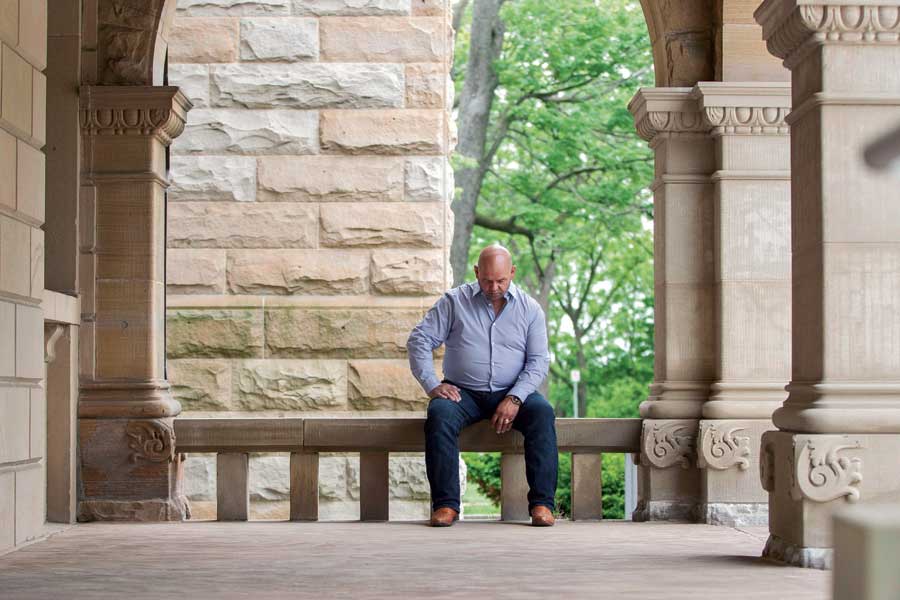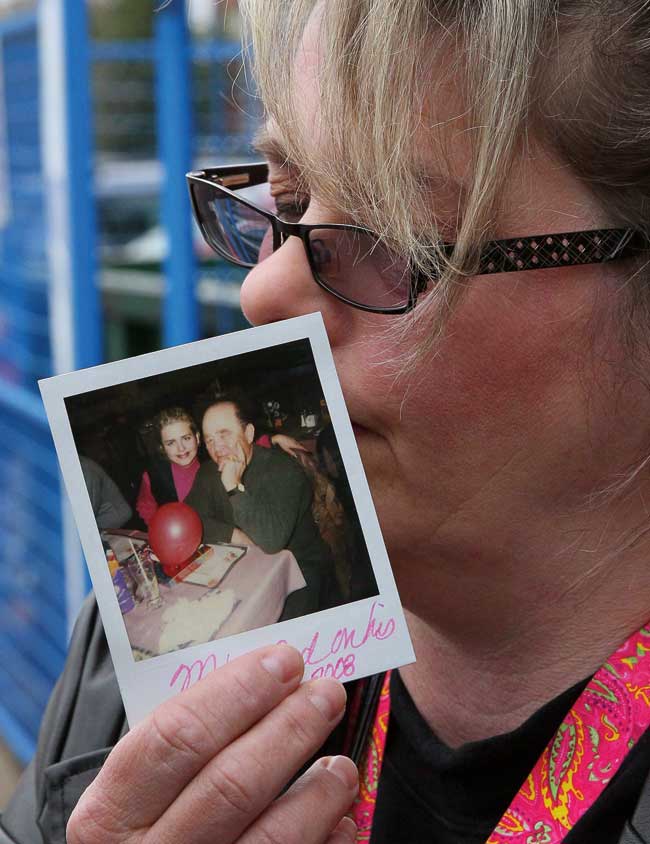Complete System Failure: Zoomer’s Investigation into the Elizabeth Wettlaufer Nursing-Home Murders

Elizabeth Wettlaufer is escorted from the provincial courthouse in Woodstock, Ont., on June 1, 2017. (Photo: The Canadian Press/Peter Power
Elizabeth Wettlaufer murdered eight seniors in Ontario nursing homes over a period of nine years. Following the public inquiry, Alex Roslin explores how budget cuts, poor staffing and ageism in the long-term care system created an environment for the serial killer to run amok.
Elizabeth Wettlaufer made an odd discovery when she was hospitalized in the psychiatric ward. Thinking about murder made her anger go away. Sort of. Wettlaufer had a lot of anger — so much that she could barely concentrate. She was also quite depressed and had been diagnosed with obsessive-compulsive behaviour.
She was in the hospital because she had tried to kill herself with an overdose of medications. When that failed, she had stolen cleaning fluid from a hospital with the idea of drinking it to commit suicide. But then, she realized something.
“If I thought about killing somebody while I was talking to other people, I could talk normally to them,” as Wettlaufer later explained. “But in this part of my mind, I was thinking about somebody I’d like to kill … It was like I had two heads.”
But whom to kill? Wettlaufer thought about killing her psychiatrist, a nurse, a co-worker. Then, after she got out of the hospital, she thought of the perfect target—seniors.
Wettlaufer had by this point been hired as a nurse at Caressant Care, a for-profit long-term care home in Woodstock, Ont., 140 kilometres west of Toronto. She seriously disliked her job from the start. Her workload on the afternoon and night shifts was unreal. Due to a dire shortage of nurses in long-term care, she often had to do double shifts, staying awake up to 24 hours.
At night, she was responsible for up to 163 residents – giving medication, changing dressings, putting on lotion, keeping up with paperwork, responding to emergencies, supervising support workers. A more appropriate staffing level would have been one nurse for each 10 or 20 residents, given the heavy needs of residents, Caressant Care staff would later say. Many residents had dementia or were extremely frail and needed extra care. Yet, a nurse could devote as little as 4.5 minutes to each resident per shift.
The stress sent Wettlaufer over the edge. “It got to the point, like fairly quickly, that I was finding it hard to handle things emotionally,” she later told lawyers working for the Long-term Care Homes Public Inquiry that the province established to investigate how Wettlaufer got away with murdering eight seniors in long-term care homes and hurting six others from 2007 to 2016.
The inquiry, which started holding hearings last June and is expected to issue a report in July, has revealed in shocking detail how various institutions failed to protect seniors from Wettlaufer. She candidly told about 10 people she had killed seniors, but no one did anything. She remained a nurse despite making dozens of medication errors and other work mistakes, for which she was most commonly not punished. Her poor record wasn’t disclosed to subsequent employers and, because of the nursing shortage, employers kept giving her another chance.

Wettlaufer was only caught because she turned herself in to police – apparently the only health-care serial killer ever to do so anywhere in the world. She is now serving eight concurrent life terms with no chance of parole for 25 years. Her frank confessions to police and inquiry lawyers give important insights into the frightening – and growing – phenomenon of health-care workers who murder those in their care. As populations age, while resources don’t keep pace, these killers are increasingly targeting seniors.
At first, Wettlaufer tried to suppress her turmoil of emotions by reciting or singing Bible verses she was raised on in her Baptist family. But as Wettlaufer’s stress shot up, she started to feel what she called a “red surge” and hear a voice in her head. She thought it was God. It urged her to murder.
She made her first attempt a few weeks after starting work at Caressant Care in June 2007. Her target was Clotilde Adriano, 87, who had diabetes. “This thought came into my head: just give her too much insulin and see what happens. So I did,” she told inquiry lawyers.
Insulin is the murder weapon of choice for serial killers who work in health care. A massive injection of insulin makes a person’s blood sugar level fall dangerously. Insulin isn’t generally monitored in nursing homes, so no one notices if some disappears. (Insulin can often be bought in pharmacies without a prescription.) Insulin also dissipates quickly from the body and can’t be detected unless a blood sample is collected within about 48 hours of death. Since there were so few staff, especially at night, Wettlaufer could often act unnoticed. If questioned, she’d explain it was a vitamin injection.
After Wettlaufer injected Adriano, the woman’s blood sugar dropped, but staff noticed and gave her juice to revive her. She survived. Wettlaufer then tried to kill Adriano’s sister-in-law, Albina deMedeiros, who was 91 and also had diabetes, but again failed.
Wettlaufer went online to research insulin and how others had used it for murder. She was better prepared for her next target, Second World War veteran James Silcox, 84, who had diabetes, Alzheimer’s and other ailments. He couldn’t walk and was often confused, asking frequently for his wife – the perfect victim to Wettlaufer’s mind. “Every patient I ever picked had some dementia,” she told inquiry lawyers. “They couldn’t report or if they reported they wouldn’t be believed.”
The night of Aug. 11, 2007, Wettlaufer was working a double shift from 3 p.m. to 7 a.m. At around 9:30 p.m., she took insulin from a storage room and injected Silcox with a massive dose. He didn’t die right away. For hours, Wettlaufer heard Silcox shouting in his room, seemingly calling to his wife. “I love you. I love you,” he repeated. At 3:55 a.m., Silcox was found with no vital signs, cold and blue.
Wettlaufer said on a form that the death was “sudden and unexpected.” This triggered a visit from a local coroner, Dr. William George. On examining the body and medical records, George pronounced the cause of death to be “complications of [a] fractured right hip.” (Silcox had broken his hip in a fall a few days before.) George declined to do an autopsy and noted that he had spoken with members of Silcox’s family, who “had no further concerns.”
In fact, Silcox’s family says George didn’t speak with them at the time and that they did have concerns. Daughter Andrea Silcox was sleeping when she got a call from one of her sisters saying their father had died. Andrea remembers sitting up in bed and responding in disbelief: “What, why would Dad be dead?” Despite his health problems, he was still physically vigorous, Andrea told Zoomer. “My dad had a will to live.”
Andrea’s sister Dianne Crawford said the coroner was “very dismissive” when she called him several weeks after their father’s death, according to Crawford’s affidavit to the inquiry. “I got the impression that the coroner felt that my call was unwarranted as my father was an elderly man and there was nothing unusual about his death,” Crawford said.
George, for his part, told the inquiry that he usually spoke with family members but didn’t keep his notes from this case to confirm he did so. He said he “would never have been dismissive” to Crawford and stood by his decision not to do an autopsy, insisting he hadn’t missed anything in his examination.

Andrea Silcox is dumbfounded by George’s response. “If they had an autopsy [right away], they would have found an overabundance of insulin in my dad’s system. How many people would have been saved?” she asked. Silcox is suing Caressant Care and Wettlaufer over her father’s murder. She says her mother was deeply affected by the news of Wettlaufer’s crime and died shortly after. “I know it was a broken heart,” Andrea Silcox says.
The notion that deaths in long-term care aren’t unexpected or worthy of closer investigation came up again and again at the inquiry. The idea was apparently drilled into the heads of nurses – Wettlaufer included. “We were told, ‘No, if they’re in a nursing home, they need care. Their death isn’t unexpected,’” Wettlaufer told inquiry lawyers.
The attitude is horrifying to Laura Tamblyn Watts, chief public policy officer at CARP, Canada’s largest seniors’ association and ZoomerMedia’s affiliate advocacy organization. “It’s an astonishing statement. Older people have every right to a safe home environment. Imagine that statement being made about any other group of people.”
In fact, the coroner’s attitude came amid moves to drastically curtail investigations into senior deaths. Coroners used to investigate every death in Ontario long-term care homes, but that changed in 1995 when provincial budget cuts reduced it to every 10th death at a facility. Even these limited investigations were slashed again in 2013 to save more money. The rule was changed to require an investigation only if a death was deemed “sudden and unexpected.” But even that paltry requirement is ignored in practice, it would seem, if long-term care deaths are never considered unexpected.
The decline in coroner investigations has come at the same time as long-term care homes struggle to provide for seniors with high needs, such as those with dementia. The portion of high-needs residents in long-term care more than doubled from 2007 to 2015 (from 35 per cent to 74 per cent), while the number of nurses hasn’t kept pace and their pay has stayed flat.
Chronic understaffing in long-term care has been a well-known problem since 2001, thanks to five earlier reports on the lack of nurses in the sector. Inadequate staffing and heavy workloads were, furthermore, blamed for abuse of seniors in the homes. What’s worse, the province also lacks enough inspectors to oversee the homes and detect abuses, inspectors told the Wettlaufer inquiry. “Given the resources that I have now, I can’t keep up,” provincial inspection manager Karin Fairchild testified.
The problems go beyond Ontario. In Quebec, long-term care residents launched a $500-million class-action lawsuit last summer complaining about “deplorable and shameful” conditions. Among the complaints: staff give seniors antipsychotic drugs in an “abusive manner” to sedate them in order to reduce workload; excessively use physical restraints on residents; give poor-quality food to lower costs; force residents to wear a diaper even if they aren’t incontinent and don’t change diapers for those who are; and demand bribes for services that residents have a right to.
This troubling environment seems to be increasingly attracting serial killers. Nursing professor Beatrice Crofts Yorker of California State University, Los Angeles, studied 131 health-care workers prosecuted for serial murder worldwide. In her initial study in 2006, 20 per cent of the victims were long-term care residents. By 2018, that portion jumped to 36 per cent, according to a report that Crofts Yorker prepared for the Wettlaufer inquiry. The overall number of health-care serial killers is also skyrocketing, from five prosecutions in 25 countries in the 1970s to 16 in the 1980s, 25 in the 1990s and 60 in the 2000s.
Crofts Yorker’s report included the same advice as the five earlier reports on long-term care in Ontario: hire more nurses. More staff could deter serial killing and improve care for all. She cited research that found each patient added to a nurse’s workload results in a seven per cent increase in a patient’s chance of dying.
After Wettlaufer’s first murder, a diabolical laughter erupted in her belly “like a cackling from the pit of hell,” she later told police. She wondered if the devil or God was talking to her. She went home, did some exercise, played some computer games and tried to forget what she had done.

But the work stress, voices and anger didn’t go away. She started to steal hydromorphone, a powerful opioid pain medicine, from the nursing home and use it once or twice a week, often while at work. She was soon drinking heavily, downing triple shots of rye and Bailey’s eight or nine times a week.
There had been warning signs earlier. She was fired from her first nursing job at a hospital after she tried to commit suicide with anxiety drugs that she had stolen. After she filed a grievance, the hospital agreed to say Wettlaufer had resigned for “health reasons.”
Wettlaufer obviously wasn’t very good at her job. Employer after employer let her poor performance slide or covered it up. At her next job, she made 18 medication errors, most of which didn’t lead to any discipline. She received a glowing reference letter extolling her “solid concern and dedication.”
Just before she joined Caressant Care, she tried to kill herself again, which is how she wound up in the hospital psychiatric ward where she first started to think about murder. A psychiatrist put her on antipsychotic and antidepressant medications.
At Caressant Care, her record included over 40 incidents of medication errors, poor attendance, inappropriate sexual comments, unprofessional behaviour, incomplete paperwork and treatment mistakes. She was briefly suspended four times, but for most of the incidents she received no discipline or only a written or verbal warning.
In one incident, several staff complained that Wettlaufer neglected patients, used unsterile scissors to puncture a resident’s hematoma, forgot to dress a second resident’s bleeding finger, ignored a third resident’s pleas for pain medicine and left a fourth resident who was having trouble breathing untreated for three days. Wettlaufer got a written warning. A few months later, a staff member complained again that Wettlaufer ignored residents asking for pain medicine. Wettlaufer acknowledged doing this with a resident but this time got no discipline.
Due to the acute nursing shortage, Caressant Care felt stuck with Wettlaufer. “She was lazy,” the home’s administrator Brenda Van Quaethem told the Wettlaufer inquiry in an affidavit. “We did think that she would rather eat than get off her chair. But we needed her. We weren’t getting applications from registered nurses.”
Something else Wettlaufer wasn’t very good at was keeping a secret. Even before she confessed in 2016, she was amazingly frank about her crimes, over the years telling friends, casual acquaintances, a cousin – about 10 people in all – that she had killed those in her care. Nobody reported it or was punished for not doing so.
“Well, you need to stop doing that,” a girlfriend reportedly responded. When Wettlaufer told her pastor and his wife, she later told police, “They prayed over me and they said to me, ‘Now this is God’s grace but, if you ever do this again, we will have to turn you in to the police.’” She decided at some point to turn herself in and confided in a lawyer. The lawyer advised her to remain silent and get help from a mental health professional, she later told police.
Why didn’t anyone go to police? Some people apparently thought Wettlaufer was making it up. In other cases, it’s not clear. “It boggles the mind,” CARP’s Laura Tamblyn Watts says of the inaction. “It speaks to the profound ageism in society. Imagine if someone confessed to killing children. The response would be immediate.”
Wettlaufer’s last victim at Caressant Care was Maureen Pickering, who was 78 and had dementia and Alzheimer’s disease. On the evening of March 22, 2014, Wettlaufer injected Pickering with a sedative, telling her it was a vitamin injection, then gave her two huge insulin injections. Pickering called out “Help, help” during the night.
By next morning, Pickering, who had previously been physically active and walking around, was found unresponsive. An ambulance took her to the hospital where an emergency room doctor, Dr. Elizabeth Urbantke, advised Caressant Care that Pickering’s blood sugar was extremely low even though she wasn’t diabetic. If she died, Urbantke said, “It might be a good idea to call the coroner on this one,” according to nursing home records.
Pickering died on March 28, 2014, and the coroner’s office was called. Assigned to the case was none other than Dr. William George, the coroner who had ruled the death of James Silcox, Wettlaufer’s first victim, “a result of complication following a fall in which he sustained a right hip fracture.” It was only the second time a coroner was called about any of Wettlaufer’s murders. George decided a coroner’s investigation wasn’t warranted and told a nurse, “No death in a nursing home is unexpected,” according to the nurse’s inquiry testimony.
George defended his inaction on Pickering’s death, telling the inquiry, “Her death was foreseeable, and it was expected.” But George’s decision was criticized by the Ontario coroner’s office and Ontario Forensic Pathology Service in their closing submission to the inquiry. They called Pickering’s case “a missed opportunity to be investigated … because there were unanswered questions” about why she died and noted that an examination may have unearthed the fact that she was murdered.

As Pickering lay dying, Caressant Care was looking into yet another medication error by Wettlaufer. She had given the wrong type of insulin to another resident, who suffered a hypoglycemic episode as a result. The incident finally prompted Caressant Care to fire Wettlaufer. The home sent a letter explaining its reasons to the College of Nurses of Ontario, which regulates the profession. It noted that Wettlaufer had been fired for putting a resident “at risk” and cited some of the previous incidents for which the nurse had been disciplined. But inexplicably, the letter listed only 10 of Wettlaufer’s 40-plus infractions.
At the nurses’ college, those 10 incidents were seen as “low risk” and didn’t trigger any censure. The college merely sent Wettlaufer a letter asking her to review her professional obligations. Had Caressant Care told the college about all of Wettlaufer’s infractions, the body would have launched a fuller investigation of her work, a college official told the inquiry.
As it was, Wettlaufer left another job with a clean slate. Far from contrite, she filed a grievance about being fired. Caressant Care settled by paying Wettlaufer $2,000 in damages, sealing her employee file and giving her a glowing reference letter that said she “proved herself a good problem-solver, with strong communication skills, who was punctual” and had left “to pursue other opportunities.”
None of this was actually true. In fact, nursing home managers believed that Wettlaufer was a danger to any resident she worked with and unfit to practise nursing, as Caressant Care vice-president Carol Hepting admitted in her inquiry testimony.
Yet, within a few weeks, the favourable reference helped Wettlaufer land a new job as a nurse at the Meadow Park long-term care home in London, Ont. There, a few months later, she killed 75-year-old Arpad Horvath with another insulin injection. His son, Arpad Horvath Jr., rushed to the hospital when he heard his dad had been found unresponsive. “I held his hand 20 minutes after he passed away,” Arpad Jr. said. “He was my best friend, my hero.” No autopsy was done.
Wettlaufer tried to kill two more seniors while working as a nurse at home-care agencies, then finally turned herself in to police in 2016 and confessed to the murders and attempted murders. Shortly after, Arpad Jr. got a call from police. They said his dad could have been murdered. “Everything stopped. There was no time. I didn’t know if I should cry or say anything,” he said.
Shock gave way to anger as the public inquiry unfolded last summer, revealing how badly institutions had failed to protect seniors from Wettlaufer and how she had gotten away with being an awful nurse in one job after another. “Nobody wanted to be held accountable. Nobody was punished,” Arpad Jr. said. “It seems to me that all the parties are accessories. Nobody monitored her. There was no control over what she did. My dad might still be here today if more was done.
“Seniors in this country are not taken care of. It sickens me,” he said.
His sister, Susan Horvath, said her father’s murder has left her severely depressed, anxious and unable to work. She doubts the inquiry will change anything. “Nobody is taking any of this seriously. The government is not going to dish out a lot of money to hire new nurses, never mind the abuse,” she said. Both Horvath siblings have filed lawsuits over their father’s murder.
“The system never reacted,” said Laura Tamblyn Watts of CARP. “The entire system is failing seniors at almost every level. We know so many of the answers but we need political will.” It remains to be seen if the horror of Wettlaufer’s deeds will make a difference.